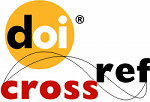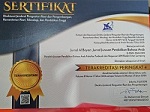Arabic Learning by Using Hybrid Learning Model in University
Abstract
Keywords
Full Text:
PDFReferences
Abazi-Bexheti, L., Kadriu, A., Apostolova-Trpkovska, M., Jajaga, E., & Abazi-Alili, H. "Learning and Teaching with Technology in the Knowledge Society; New Literacy, Collaboration and Digital Content".Business Systems Research 9, no. 1 (2018): 978-981.
Awatif, A. R., Hairun Najuwah, J., Ku Fathiyah, K. A., & Siti Nurhajariah, M. I. "Penguasaan Bahan Bacaan Bahasa Arab Melalui Teknik Membaca SQ3R". Journal of Social Sciences and Humanities (2016): 69-80.
Awouters, V., & Jans, S. "E-learning Competencies For Teachers In Secondary And Higher Education". International Journal of Emerging Technologies in Learning 4, no. 2 (2009): 58–60.
Azura, W., Ahmad, W., & Rahman, L. A. Pembelajaran bahasa Arab di Universiti Sains Islam Malaysia ( USIM ): Tinjauan Kecenderungan Pelajar (2007),1-14.
Bala, J., & Wechsler, H. Shape, "Analysis Using Hybrid Learning". Pattern Recognition 29, no.8 (1996): 1323–1333.
Boccardelli, P., Annosi, M. C., Brunetta, F., & Magnusson, M. Learning and innovation in Hybrid organizations: Strategic and organizational insights (2017), 9.
Carbonara, D. D. Technology Literacy Applications in Learning Environments, Book, (2005), 53-59.
Astro, R.. "Blended Learning In Higher Education: Trends And Capabilities". Education And Information Technologies 24, no. 4 (2019): 2523–2546.
Chen, B. H., & Chiou, H. H. "Learning Style, Sense of Community and Learning Effectiveness in Hybrid Learning Environment". Interactive Learning Environments 22, no. 4 (2014): 485–496.
Cremers, P. H. M., Wals, A. E. J., Wesselink, R., & Mulder, M. "Design Principles For Hybrid Learning Configurations at the Interface Between School And Workplace". Learning Environments Research 19, no. 3 (2016): 309–334.
Dakers, J. R. Defining Technological Literacy Towards An Epistemological Framework (2006), 1-2
Dee Fink, L. New Directions for Teaching and Learning (2009),119.
Dhian, A. "Identifikasi Kesulitan Belajar Siswa Kelas V SD Negeri Sosrowijayan Kota Yogyakarta". Jurnal Pendidikan Guru Sekolah Dasar (2016): 169-182.
Erwhintiana, I., & Basid, A. "Analisis Diagnostik Kesulitan Belajar Maharah Kalam Mahasiswa Bahasa dan Sastra Arab" (2017): 5.
Fong, J., Au, T., & Cheung, S. K. S.. "Hybrid Learning With Archived Lectures And Tutorials". International Journal Of Innovation And Learning (2013): 13.
Gilakjani, A. P., & Sabouri, N. B. "Teachers’ Beliefs in English Language Teaching and Learning: A Review of the Literature". English Language Teaching 10, no. 4 (2017).
Hayati, N., & Wijaya, M. "Pengelolaan Pembelajaran Melalui Blanded Learning Dalam Meningkatkan Receptive Skill Peserta Didik di Pondok Pesantren". Palapa, 6, no. 2 (2018): 1–18.
Haythornthwaite, C., & Andrews, R. N. L. E-Learning Theory And Practice (2011).
Hj. Yaakub, M. B. "Teaching Arabic as a Second Language: An Evaluation of Key Word Method Effectiveness". Jurnal Teknologi 46, no. 1 (2007).
Ilyas, A. "Dosen Bahasa Arab Dan Kompetensinya". 10, no. 1 (2018): 86–102.
Islam, U., Sunan, N., Makruf, I., & Arsyad, A. "Implementasi Model Fungsional Dalam Pembelajaran Bahasa Arab di MTs N". AL- Shaut Al- ‘ Arabiyah (2011): 173–192.
Khadijah, N., Bakar, A., & Arifin, Z. "Penggunaan Strategi Belajar Bahasa Dalam Pembelajaran Bahasa Arab Sebagai Bahasa Kedua: Satu Sorotan". Prosiding Seminar Pengajaran & Pembelajaran Bahasa Arab (2014).
Klimova, B. F., & Kacetl, J. "Hybrid Learning and its Current Role in the Teaching of Foreign Languages". Procedia - Social and Behavioral Sciences (2015): 477–481.
Li, X., Dong, S., & Venuvinod, P. K.. "Hybrid learning for tool wear monitoring". International Journal of Advanced Manufacturing Technology 16, no. 5 (2000): 303-307.
Linamalini binti Mat Nafi & Kamarul Shukri bin Mat Teh. "Penggunaan Strategi Pembelajaran Bahasa Arab Sebagai Bahasa Kedua: Satu Kajian Di Institusi Pengajian Tinggi Kelantan". Prosiding Seminar Pengajaran & Pembelajaran Bahasa Arab (2014).
Maghfirah, A. F. "Kreativitas Dosen dalam Meningkatkan Minat Belajar Bahasa Arab Mahasiswa di IAIN Surakarta". Academica Journal of Multidisciplinary Studies (2017): 19–33.
Manian, C. "Designing Student Oriented Elearning Environments in Higher Education to Match Technological Trends". International Journal on Integrating Technology in Education 2 no. 3 (2013): 1–11.
Mastura Arshad, & Kaseh Abu Bakar. "Penggunaan Strategi Pembelajaran Kemahiran Bertutur Bahasa Arab: Kajian Di Pusat Asasi UIAM". Persidangan Kebangsaan Pengajaran Dan Pembelajaran Bahasa Arab 2012 (PKEBAR’12), Prosiding (2012).
Mei, S. Y., Ju, S. Y., & Mohd, A. B. "Cooperative Learning Strategy in teaching Arabic for Non Native Speakers". European Journal of Social Sciences Education and Research 11, no. 2 (2017): 261.
Mufidah, N., Salamah, U., Muthoharoh, I., & Irfan Islamy, M. "Hybrid Learning Dalam Pembelajaran Kosa Kata Bahasa Arab pada Anak Berbantuan Media Al-Mutho". Journal AL-MUDARRIS, 2, no. 1 (2019): 40.
Mustari, M. I., Jasmi, K. A., Muhammad, A., & Yahya, R. "Model Pengajaran dan Pembelajaran Bahasa Arab". Seminar Antarabangsa Perguruan Dan Pendidikan Islam [SEAPPI2012]. Prosiding (2012).
Nasution, S., & Zulheddi, Z. "Pengembangan Model Pembelajaran Bahasa Arab Berbasis Teori Konstruktivisme Di Perguruan Tinggi". Arabi : Journal of Arabic Studies 3, no. 2 (2018): 121.
Raes, A., Detienne, L., Windey, I., & Depaepe, F. "A Systematic Literature Review On Synchronous Hybrid Learning: Gaps Identified". Learning Environments Research (2019).
Reyna, J., Hanham, J., & Meier, P. C. "A Framework For Digital Media Literacies For Teaching And Learning In Higher Education". E-Learning and Digital Media, 15, no. 4 (2018): 176–190.
Rogers, A. "Global Media Literacy In A Digital Age: Teaching Beyond Borders". International Review Of Education, 63, no. 1 (2017): 137–139.
Ross, V., Murphy, C., MacNeill, A., & Masson, "A. Hybrid Learning Model-A Framework for Teaching and Learning Practice". International Journal of Emerging Technologies in Learning 3, no. 1 (2008): 12–17.
Salaberry, M. R. "The Use Of Technology For Second Language Learning And Teaching: A Retrospective". Modern Language Journal 85, no. 1 (2001): 39–56.
Setyaningrum, W. "Blended Learning: Does It Help Students In Understanding Mathematical Concepts?". Jurnal Riset Pendidikan Matematika 5, no. 2 (2018): 244–253.
Singer, N., & Mahmoud, E. F. E. S. "Motives Of The Egyptian Education Future For Sustainable Development: A Comparative Analysis Between 2020 And 2030". Humanities And Social Sciences Reviews, 8, no. 2 (2020): 1–28.
Snart, J. "Hybrid Learning at the Community College". New Directions for Teaching and Learning (2017): 59–67.
Su, M., & Basu, M. "A Hybrid Learning System For Image Deblurring". Pattern Recognition 35, no. 12 (2002): 2881–2894.
Subur, S. "Model dan Strategi Pembelajaran Bahasa Arab". INSANIA : Jurnal Pemikiran Alternatif Kependidikan 11, no. 2 (1970): 164–175.
Sun, R., & Peterson, T. "Some Experiments With A Hybrid Model For Learning Sequential Decision Making". Information Sciences 11, no. 4 (1998): 83–107.
Supardi, S. "Model Pembelajaran Bahasa Arab Terpadu di Perguruan Tinggi Keagamaan Islam Negeri". LISANIA: Journal of Arabic Education and Literature 2, no. 1 (2018): 13.
Tajuddin, S. "Pengembangan Model Pembelajaran Bahasa Arab". Jurnal Perameter 29, no. 2 (2016): 200–215.
Tanguma, J., Liu, L. C., Koong, K. S., & Tanguma, J. "Hybrid learning and effects on student assessment outcomes". International Journal of Mobile Learning and Organisation 2, no. 1 (2008): 36–47.
Thorne, K. Blended Learning: How to Intergrate Online Learning and Traditional Learning. In Kogan (2003).
Tsihrintzis, G. A., Sotiropoulos, D. N., & Jain, L. C. "Machine learning paradigms: Advances in data analytics". Intelligent Systems Reference Library 149 (2019).
Wang, F. L., Fong, J., & Kwan, R. C. Handbook of Research on Hybrid Learning Models: Advanced Tools, Technologies, and Applications (2009).
Wekke, I. S. "Arabic Teaching and Learning: A Model from Indonesian Muslim Minority". Procedia - Social and Behavioral Sciences 191 (2015): 286–290.
Yadegaridehkordi, E., Shuib, L., Nilashi, M., & Asadi, S. "Decision to Adopt Online Collaborative Learning Tools in Higher Education: A Case of Top Malaysian Universities".Education and Information Technologies 24, no. 1 (2019): 79–102.
Yang, H. F., & Chen, Y. P. P. "Hybrid Deep Learning And Empirical Mode Decomposition Model For Time Series Applications". Expert Systems With Applications (2019): 128–138.
Yaqub, M. T. "Developing Speaking Skill in Arabic Learners : A Proposal for Integration of Product and Process Approaches". European Scientific Jounal 8, no. 29 (2012): 140–149.
Yen, S. C., Lo, Y., Lee, A., & Enriquez, J. M. "Learning Online, Offline, And In-Between: Comparing Student Academic Outcomes And Course Satisfaction In Face-To-Face, Online, And Blended Teaching Modalities". Education and Information Technologies Journal 23, no. 5 (2018): 2141–2153.
Zamri, A., & Ibtisam, A. "Metode Pengajaran dan Pembelajaran Bahasa Arab Berasaskan Empat Kemahiran". Prosiding Seminar Pengajaran & Pembelajaran Bahasa Arab (2014).
DOI: http://dx.doi.org/10.24042/albayan.v13i1.7811
Refbacks
- There are currently no refbacks.
Copyright (c) 2021 Jurnal Al Bayan: Jurnal Jurusan Pendidikan Bahasa Arab
License URL: https://creativecommons.org/licenses/by-sa/4.0
Editorial Office:
Jurnal Al Bayan: Jurnal Jurusan Pendidikan Bahasa Arab, Arabic Education Study Program, Faculty of Education and Teachers Training, Unversitas Islam Negeri Raden Intan Lampung
Jl. Endro Suratmin 1 Sukarame, Bandar Lampung 35131-Indonesia
e-mail: jurnalalbayan@radenintan.ac.id
http://ejournal.radenintan.ac.id/index.php/albayan/index
Jurnal Al Bayan: Jurnal Jurusan Pendidikan Bahasa Arab is licensed under a Creative Commons Attribution-ShareAlike 4.0 International License. p-ISSN 2086-9282 | e-ISSN 2549-1229









